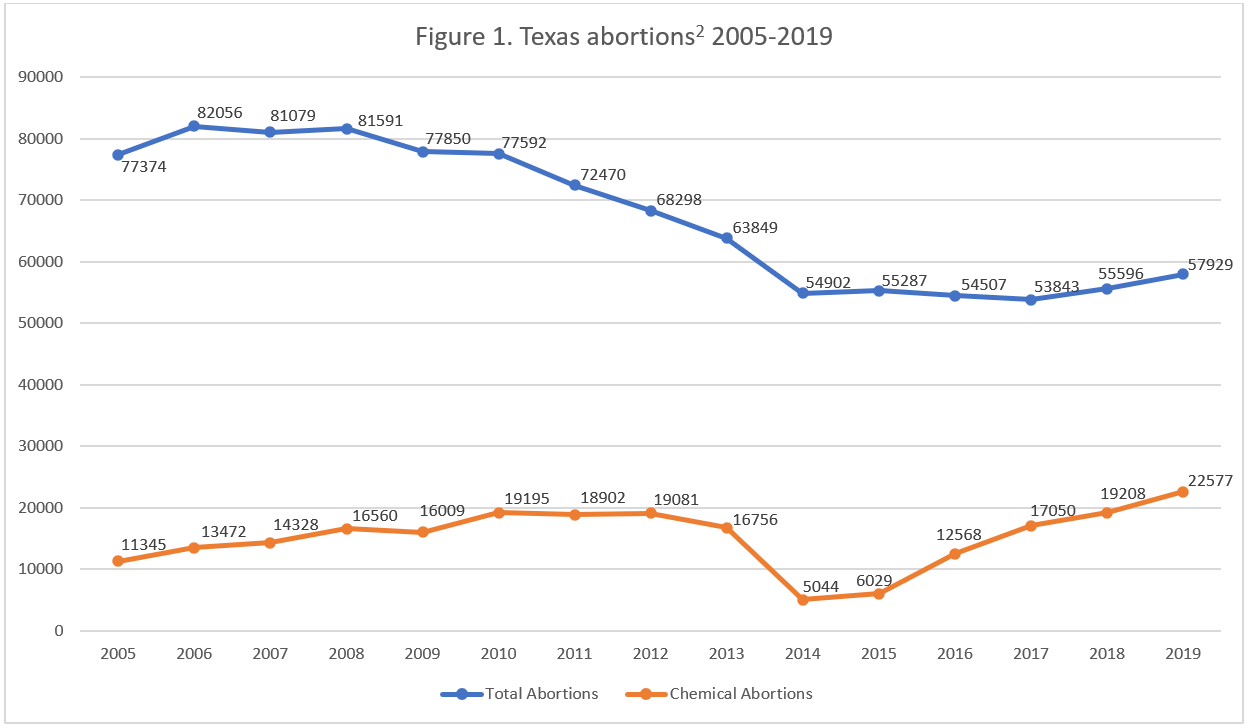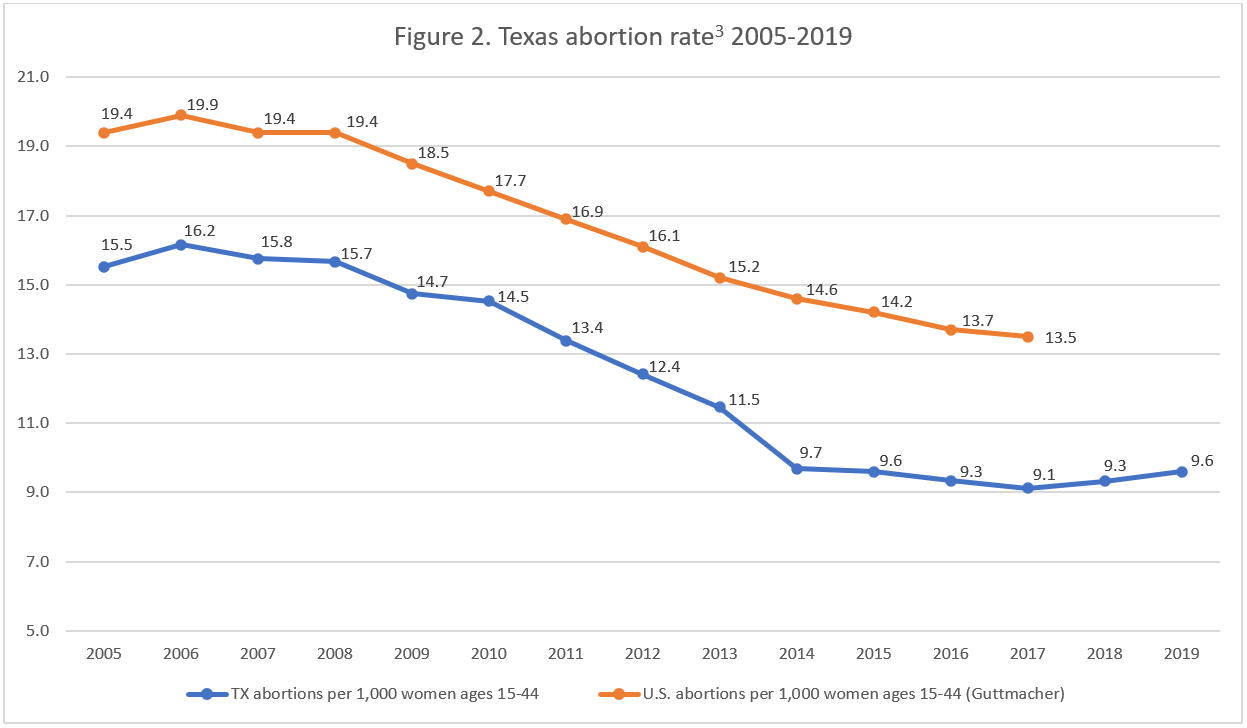Abortion Reporting: Texas (2019)

Texas’ annual abortion reports for 2018 and 2019 were both published in December 2020. The reports indicate that chemical abortion continues to increase in the Lone Star State.
Changes in Texas Abortions, 2018-2019

Information on Planned Parenthood’s Texas abortion market share is not included in the abortion report.
Abortion Totals and Trends
There were 57,929 abortions reported by Texas in 2019, up four percent from the previous year and eight percent from 2017 (Fig. 1). In 2019, 97 percent of the abortions were performed on Texas residents in Texas, while two percent were on women from other states. One percent were performed on Texas residents in other states. Thirty-nine percent of Texas abortions were chemical abortions in 2019. Chemical abortions increased by 18 percent from the previous year. The Charlotte Lozier Institute (CLI) estimates that Texas’ abortion rate in 2019 was 9.6 abortions per 1,000 women ages 15 to 44, up three percent from 2018 but still lower than the national rate (Fig. 2).
State Report Summary
Nine percent of Texas abortions were performed on girls under the age of 20, including 0.2 percent on girls under the age of 15. Fifty-eight percent of the abortions were obtained by women in their twenties, with 29 percent on women ages 20 to 24 and 28 percent on women ages 25 to 29. Thirty percent of the abortions were performed on women in their thirties, and four percent were performed on women age 40 or older.
Hispanic women composed the largest racial group undergoing abortions, making up 38 percent of the total. Twenty-eight percent of the abortions were performed on black women, and 26 percent were on white women. Asian women represented six percent of the total. Native American women underwent 0.2 percent of Texas abortions, while one percent were on women of other races and another 0.2 percent on women whose race was not reported. CLI estimates that the non-Hispanic black abortion rate was 19.7 abortions per 1,000 women ages 15 to 44, nearly three times the non-Hispanic white rate of 6.8. The Hispanic abortion rate was 8.6.
Over half the abortions (56 percent) were performed using suction curettage. Thirty-nine percent were chemical abortions, and five percent were dilation and evacuation procedures. There were 13 sharp curettage abortions, two hysterectomy or hysterotomy procedures, and two intra-uterine instillation abortions. Eighty-eight abortions were performed via other or unreported means.
The vast majority of Texas abortions, 84 percent, occurred at eight weeks post-fertilization (approximately 10 weeks of gestation) or earlier. Seven percent were performed between nine and 10 weeks, and four percent were reported between 11 and 12 weeks. Two percent occurred between 13 and 14 weeks post-fertilization, dropping to one percent between 15 and 16 weeks and 1.5 percent between 17 and 20 weeks post-fertilization. Texas limits abortion at or after 20 weeks post-fertilization, when unborn babies can feel pain. The state report does not include the exact number of abortions performed after 20 weeks post-fertilization but does show that just 13 abortions were reported at 21 weeks post-fertilization or later (around 23 weeks of gestation or later). Of these, 11 were performed between 21 and 24 weeks post-fertilization, and two were performed at or after 25 weeks. Five of the 21-plus-week abortions occurred out-of-state, seven were performed in Texas hospitals, and one was performed in an ambulatory surgery center.
Overall, 50 percent of Texas abortions occurred in centers classified as ambulatory surgical centers, and 49 percent were performed in centers classified as abortion facilities. One percent were performed out-of-state, and 0.1 percent occurred in hospitals in Texas. No abortions were reported by doctor’s offices.
Some of the information in the report, including the marital status and pregnancy history of women who obtain abortions, is only available for abortions performed on Texas residents. Eighty-three percent of Texas resident abortions were on unmarried women, while 17 percent were on married women and 0.3 percent on women of unknown marital status. Forty percent were on women with no previous live births, compared to 24 percent on women with one prior live birth and 36 percent on women with two or more. Sixty-two percent of the abortions were on women with no prior abortions reported. A quarter were obtained by women with one previous abortion, and 13 percent were on women with more than one previous abortion.
Complications
In 2017, Texas passed a bill to strengthen and enforce its abortion complication reporting law that went into effect partway through 2018. Under the new law, when a complication is diagnosed or treated, the physician must report it within three business days, and the facility must report it within 30 days. The law applies to a physician who performs an abortion or works for an abortion center, and a health care facility that diagnoses or treats a woman with an abortion complication. Because physicians and health care facilities are required to report separately, this information is reported in two individual tables in the annual report.
The law maintains that the report must not contain duplicate data, so the report explains that identical complication reports are counted as duplicates and one is removed from the records. In 2019, facilities submitted 229 reports with information on 244 unduplicated complications.1 The report cautions that multiple complications can result from a single abortion.
The most common complication was incomplete abortion, reported 111 times in 2019. There were 37 cases of hemorrhage and 30 infections. Eight uterine perforations were reported, followed by six cervical lacerations, five instances of aspiration/allergic response, and one instance each of sepsis and damage to the uterus. There were 37 other, unspecified complications.
Since 2013, Texas has reported information on babies who survive abortions with the rest of its complication data, but zero born-alive babies have been reported. However, in 2018, five babies were reported to have been born alive during abortions, with four of them reported after the improvements to Texas’ complication reporting went into effect. In 2019, Texas enacted a new law to strengthen protections for babies who survive abortions, and six born-alive babies were reported. The Texas Attorney General’s Office announced that it is investigating these abortion survivors.
State Ranking
In 2016, a CLI survey of abortion reporting across the country tied Texas’ reporting for 15th best. Since then, Texas has improved its reporting, strengthening its complication data and increasing the speed with which reports are released. To improve its reporting further, Texas could identify the states to which Texas residents travel for abortions and the states from which nonresident women travel to Texas. Additionally, Texas could report the precise number of abortions performed at or after 20 weeks post-fertilization, the legal limit.


- Statistics on abortion complications reported here represent a minimal number of deaths and complications.
- The annual totals of chemical abortions shown here differ from earlier summaries. Previous summaries showed the number of chemical abortions performed on Texas residents from 2005 to 2015; this chart also includes chemical abortions performed on nonresidents in Texas.
- Rates were calculated by CLI using population estimates from the United States Census Bureau. The rates were calculated using the following formula: (total number of abortions reported to Texas ÷ number of resident women ages 15-44) x 1,000. Rates may differ slightly from previous CLI articles due to revised population estimates.
























